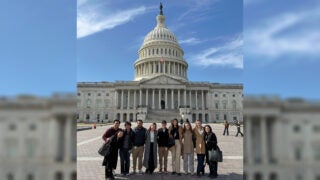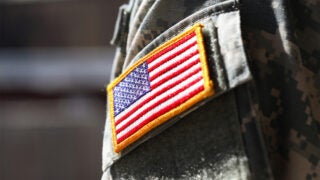USC postal crew keeps customers safe amid influx of mail during coronavirus era
As many USC employees work remotely, their letters and parcels amass on campus. The university’s mail specialists explain how they handle the postal pileup with rigorous safety precautions.
Neither snow nor rain nor heat nor — COVID-19?
The unofficial creed of the postal worker might need an update, given the dramatic changes brought about by the new coronavirus pandemic. It’s certainly true for USC’s mailing services team, which had to quickly rework how it handles thousands of letters and parcels.
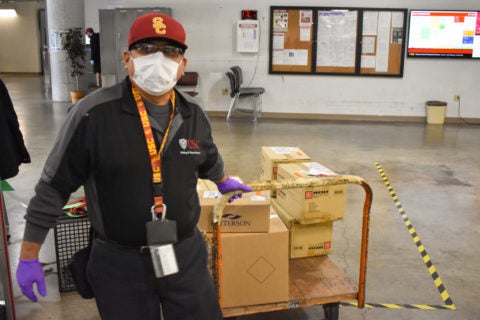
Employees wear protective gear to reduce risk of contracting and spreading the virus, even as they deliver mail to far fewer locations — and do so less often. Many envelopes and boxes originally bound for USC offices and labs now get sorted and pile high in secure mail cages or bins, waiting for pickup. Some items remain on hold indefinitely.
“Let’s call it organized chaos,” said Gretchen D’Auria, a special project and marketing manager with USC Mailing and Material Management Services. “It’s been everyone coming together in selfless cooperation — many hands making what would have been a daunting task possible. We basically revamped in short order with a whole new model of business.”
Lila Mauro, associate vice president and chief procurement officer for USC, said members of the mail team have been deemed essential employees, and they’re still working hard. “They are definitely on the front lines of keeping USC running,” she said.
Critical mail deliveries continue to USC medical facilities, including protective gear
Before the COVID-19 pandemic, the mail department served more than 160 buildings at four USC locations: University Park Campus, Health Sciences Campus, downtown Los Angeles and Alhambra. Now USC mail carriers visit only 22 buildings deemed essential. Many other USC locations have closed to limit the spread of the virus.
Critical items still arrive daily at Keck Medicine of USC’s hospitals and health clinics. Recently, carriers proudly delivered much-needed protective medical supplies to Keck Medicine and the health system’s emergency operations center, for example.
“Those are some of those hot items that nobody can find right now: gloves, masks, sanitizers — all those essential items every hospital needs,” said Nita Pilate, interim director of USC Mailing and Material Management Services.
Most of the 22 locations still served by mail carriers, though, now get deliveries only once or twice a week. Mail addressed to the remaining 142 buildings goes to a central location near the University Park Campus.
If they don’t opt for occasional deliveries, the university’s 518 departments with a mail code now have two other options for their incoming letters and flat packages:
- Mail can be held at the central facility for pickup or delivery after staff members return to the office.
- Department representatives can collect their mail in person at that same facility by scheduling a pickup appointment.
The central mail services team also receives many of the bulkier packages that normally would have been delivered directly to campus or other university properties, Pilate said.
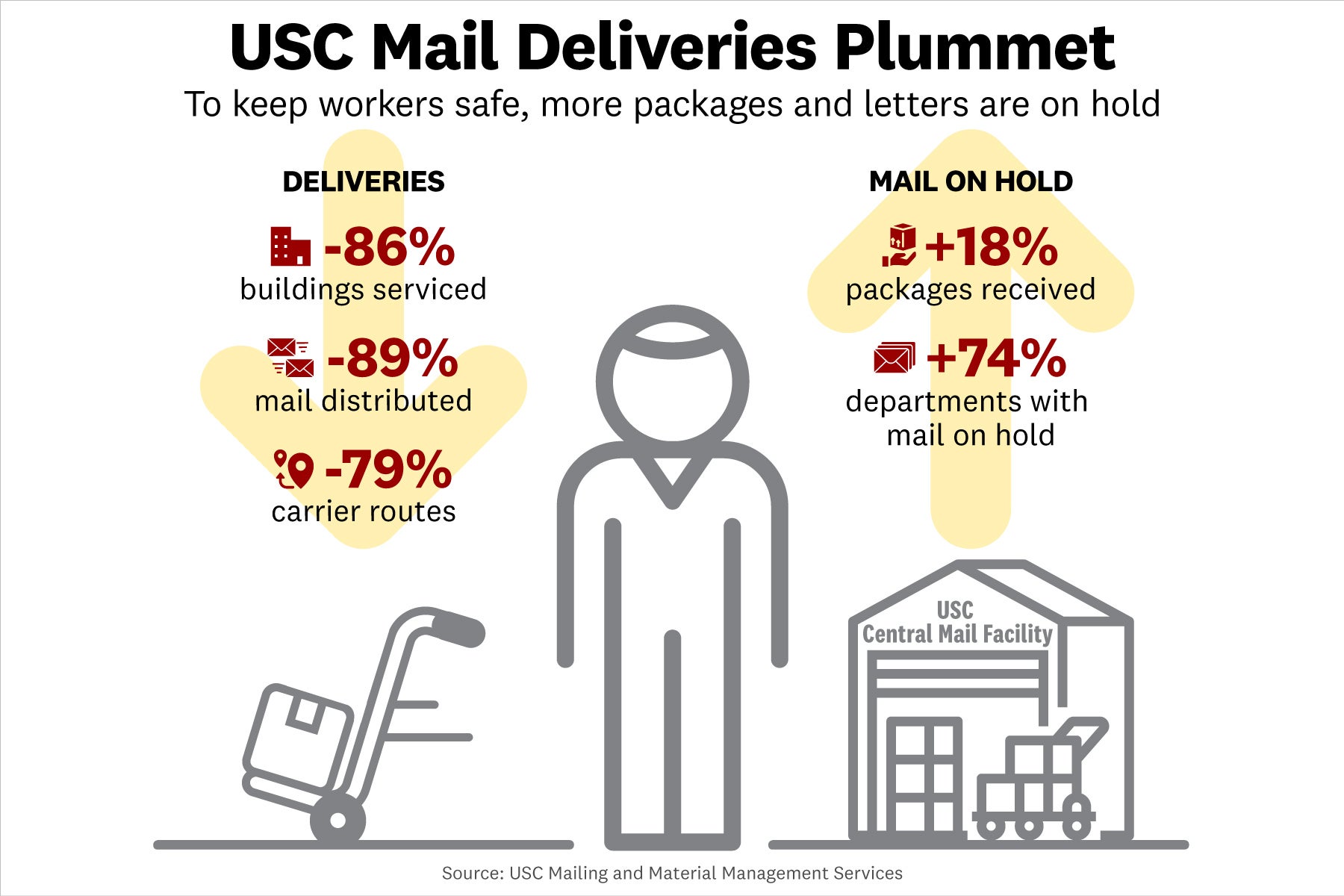
Rather than waiting for delivery, 81 departments choose to gather their mail at the central facility on Hope Street, usually once or twice a week. The mailing services team maintains strict guidelines for safe social distancing during pickups, D’Auria said, and staff members wear gloves and face protection. USC Department of Public Safety officers also monitor the situation to ensure everyone follows the rules.
“We’re having department reps place their ID on a table, and we scan it from 6 feet away,” Pilate said. “Then we put their mail on that table and walk away.”
Uptick in packages keeps USC postal workers busy during coronavirus pandemic
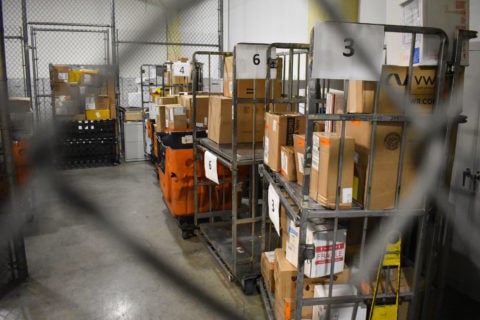
One unexpected outcome of the COVID-19 emergency is a dramatic increase in the number of packages delivered to the central mailing office because few people remain on campus to accept them. Parcels now account for 22% of all incoming mail, compared to 4% before the pandemic — and it’s not because the flow of letters and other mail has slowed, according to the mailing services team. As of the second week of April, Pilate’s team of postal workers had more than 750 packages stored in 16 mail cages, awaiting delivery or pickup.
“People ordered things before they knew this was going to happen,” Pilate said. “We’re seeing lots of Amazon and Office Depot packages. We are also getting quite a few laptop deliveries for departments that need those for employees working at home.”
Although USC’s central facility boasts an impressive automated sorting machine for letters and flat packages, employees sort all larger parcels by hand. Twelve staff members remain on site to handle sorting, pickups and deliveries.
They also field email requests and phone calls. A surge in inquiries occurred during the week of March 16, when many USC employees first began working from home. The mail department received 422 emails that week, compared to 17 emails the week before. That weekly tally has since leveled off to several hundred emails, along with a precipitous decrease in orders for materials needed for research labs.
“The last five days, we’ve had an average of one order,” Pilate said. “Usually, we’d have 10 to 12 orders a day.”
USC postal workers sort and store tens of thousands of letters and parcels
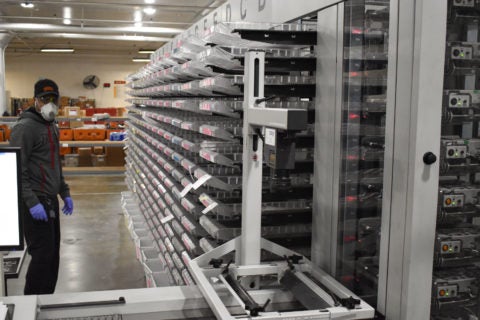
Storage is yet to be an issue, although Pilate said plans are in the works to identify other areas where mail can be set aside until the university resumes normal business. For now, every postal item is sorted by route and kept in a secure location at the main facility.
“We’re getting so many calls: ‘Did I get this package? Did I get this letter?’” Pilate said. “We know exactly where to go for that department’s mail.”
At last count, the mail crew had separated letters and flat packages into 131 mail bins, representing about 45,850 individual postal items.
Although they aren’t worried about running out of space as the amount of mail on hold at the facility multiplies, Pilate and her colleagues are beginning to look ahead.
“We’re already thinking about what happens when everyone returns,” she said. “It’s going to be a lot of work to get all this mail out to the departments.”

